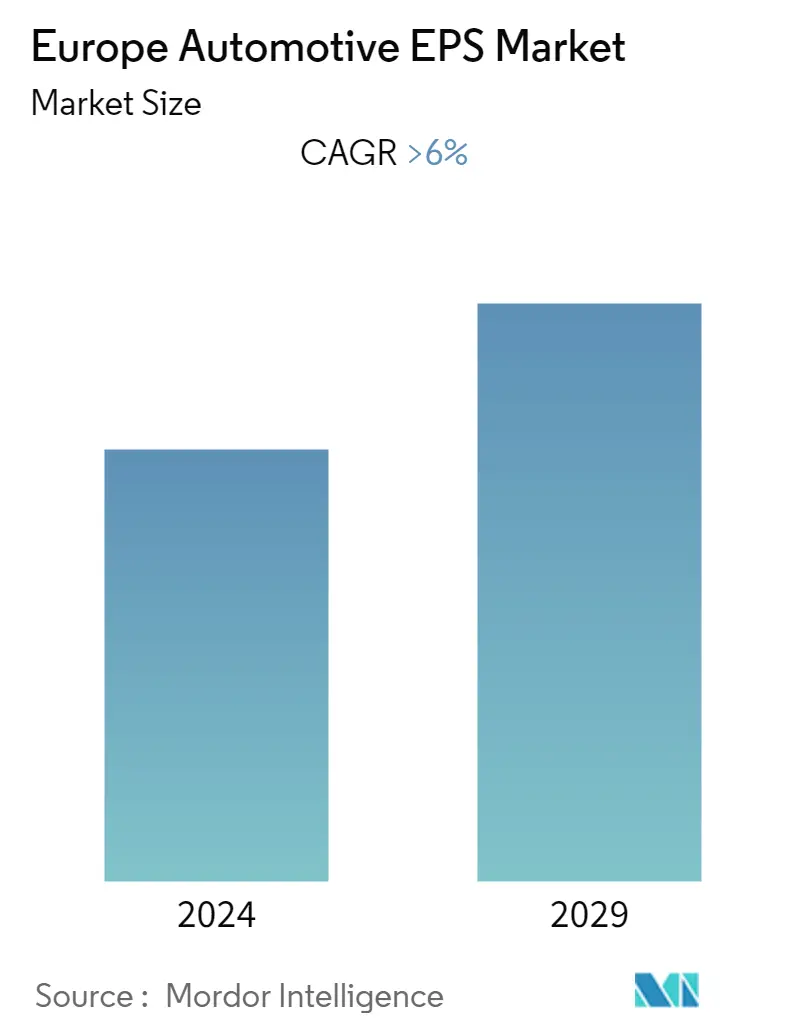Market Size of Europe Automotive EPS Industry

| Study Period | 2019 - 2029 |
| Base Year For Estimation | 2023 |
| Forecast Data Period | 2024 - 2029 |
| Historical Data Period | 2019 - 2022 |
| CAGR | 6.00 % |
| Market Concentration | Medium |
Major Players_MAjor_player.webp)
*Disclaimer: Major Players sorted in no particular order |
Europe Automotive EPS Market Analysis
The Europe Automotive Electric Power Steering (EPS) Market is projected to grow with a CAGR of more than 6% during the forecast period.
- The integration of numerous steering sensors in an electric power steering (EPS) helps provide additional safety benefits to the driver. Moreover, the enactment of stringent fuel economy norms, along with safety initiatives by the governments and international associations, are considered important drivers for the growth and development of the advanced steering systems.
- Electric power steering systems are fuel-efficient as compared to the other alternatives, which is due to the absence of belt-driven hydraulic or manual pumps, which run constantly, whether assistance is required or not. EPS provides fuel savings as high as 0.4 l for every 100 km, along with a reduction in CO2 emissions of up to 7 g/km.
- Major automakers have their own electric power steering systems such as Ford adaptive power steering. Adaptive steering systems of Ford utilize a precision-controlled actuator just inside the steering wheel, without making any changes to its traditional steering system. Adaptive steering makes the car more nimble and easier to turn.
- Large commercial vehicles, such as buses and trucksare different from passenger cars, as the large vehicles have the requirementof higher torque to provide steering assistance, additionally they have much higher mileages, heavier loads and more constant use than passenger cars, due to all the above reasons EPS is a much needed solution for commercial vehicles.
Europe Automotive EPS Industry Segmentation
The Europe automotive EPS market covers the latest trends and technological development and market demand by type, component type, vehicle type, country, and market share of major automotive EPS manufacturing companies across Europe.
| By Type | |
| Column Type, | |
| Pinion Type | |
| Dual Pinion Type |
| By Component Type | |
| Steering Rack/Column | |
| Sensor | |
| Steering Motor | |
| Other Components |
| By Vehicle Type | |
| Passenger Cars | |
| Commercial Vehicles |
| By Country | |
| Germany | |
| United Kingdom | |
| Italy | |
| Spain | |
| France | |
| Rest of Europe |
Europe Automotive EPS Market Size Summary
The Europe Automotive Electric Power Steering (EPS) Market is experiencing significant growth, driven by the increasing integration of advanced steering sensors that enhance driver safety. The shift from traditional hydraulic systems to EPS, which utilizes digital sensors and motors, is a key factor in this expansion. This transition is further supported by stringent fuel economy regulations and safety initiatives from governments and international bodies, which are encouraging the adoption of more efficient and environmentally friendly steering systems. EPS systems are particularly beneficial for large commercial vehicles, such as buses and trucks, which require higher torque and have more constant usage compared to passenger cars. The fuel efficiency and reduced CO2 emissions offered by EPS systems make them an attractive option for automakers looking to meet regulatory standards and improve vehicle performance.
The European automotive steering sensor market is moderately consolidated, with major players like Robert Bosch GmbH, Continental AG, and TE Connectivity leading the industry. These companies are actively engaging in partnerships and collaborations to maintain their competitive edge. Recent advancements in steering sensor technology, such as Hella's contactless inductive position sensor and Infineon Technologies' linear Hall sensor, are enhancing the functionality and safety of EPS systems. The market's growth is also supported by the recovery of the automotive industry in Germany and other European countries, following the disruptions caused by the COVID-19 pandemic. Collaborations, such as the one between NSK Ltd. and Volkswagen AG, are further strengthening the market position of key players, ensuring continued innovation and development in the EPS sector.
Europe Automotive EPS Market Size - Table of Contents
-
1. MARKET DYNAMICS
-
1.1 Market Drivers
-
1.2 Market Restraints
-
1.3 Industry Attractiveness - Porter's Five Forces Analysis
-
1.3.1 Threat of New Entrants
-
1.3.2 Bargaining Power of Buyers/Consumers
-
1.3.3 Bargaining Power of Suppliers
-
1.3.4 Threat of Substitute Products
-
1.3.5 Intensity of Competitive Rivalry
-
-
-
2. MARKET SEGMENTATION
-
2.1 By Type
-
2.1.1 Column Type,
-
2.1.2 Pinion Type
-
2.1.3 Dual Pinion Type
-
-
2.2 By Component Type
-
2.2.1 Steering Rack/Column
-
2.2.2 Sensor
-
2.2.3 Steering Motor
-
2.2.4 Other Components
-
-
2.3 By Vehicle Type
-
2.3.1 Passenger Cars
-
2.3.2 Commercial Vehicles
-
-
2.4 By Country
-
2.4.1 Germany
-
2.4.2 United Kingdom
-
2.4.3 Italy
-
2.4.4 Spain
-
2.4.5 France
-
2.4.6 Rest of Europe
-
-
Europe Automotive EPS Market Size FAQs
What is the current Europe Automotive EPS Market size?
The Europe Automotive EPS Market is projected to register a CAGR of greater than 6% during the forecast period (2024-2029)
Who are the key players in Europe Automotive EPS Market?
Robert Bosch GmbH , NSK Ltd., ZF Friedrichshafen AG, JTEKT Corporation and Nexteer Automotive Group Ltd are the major companies operating in the Europe Automotive EPS Market.

